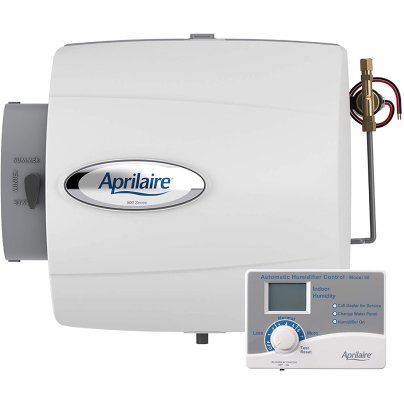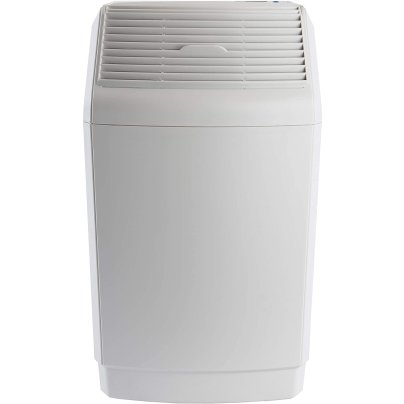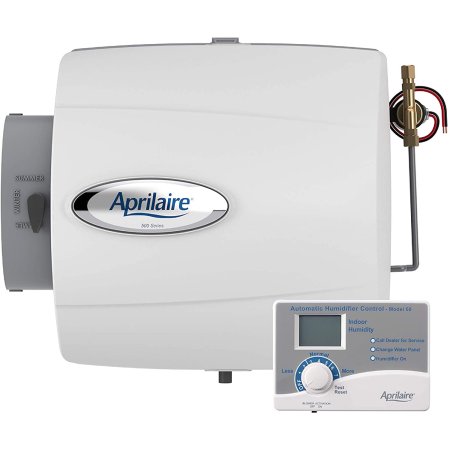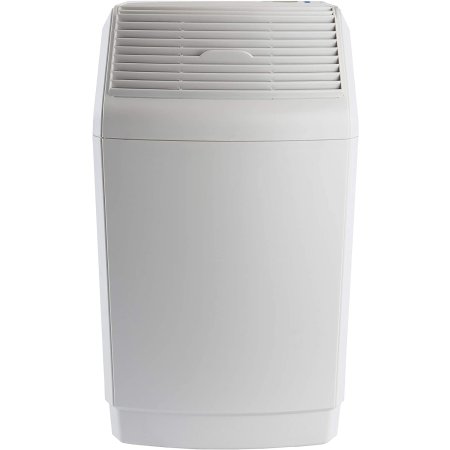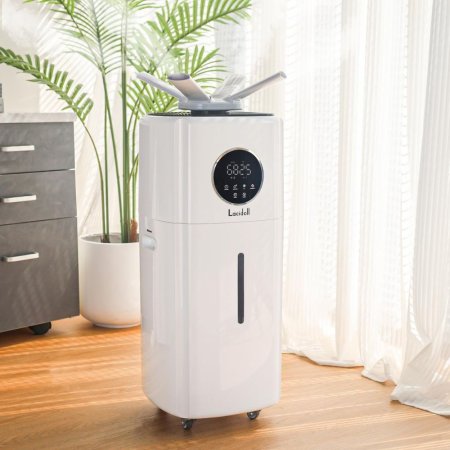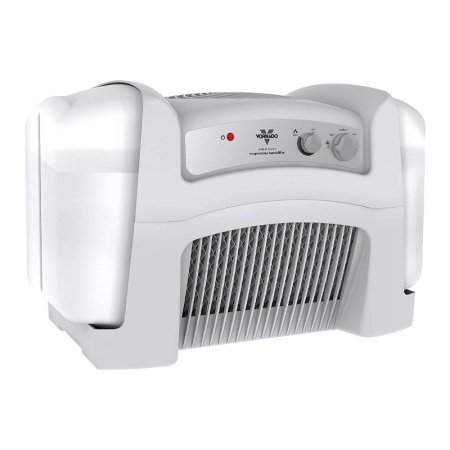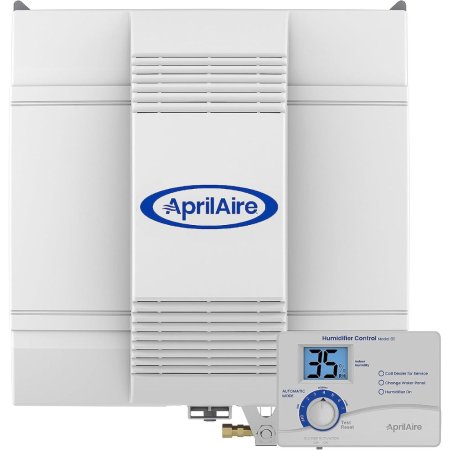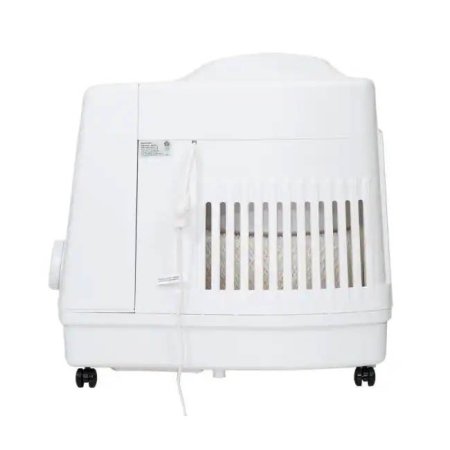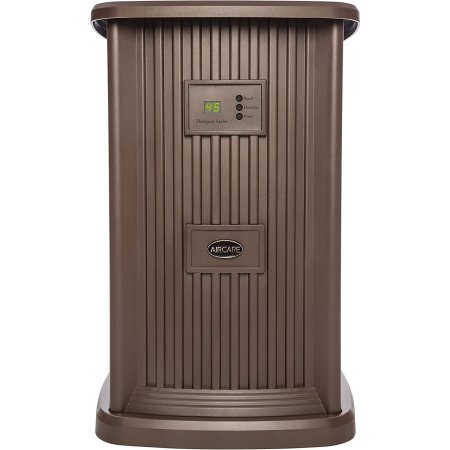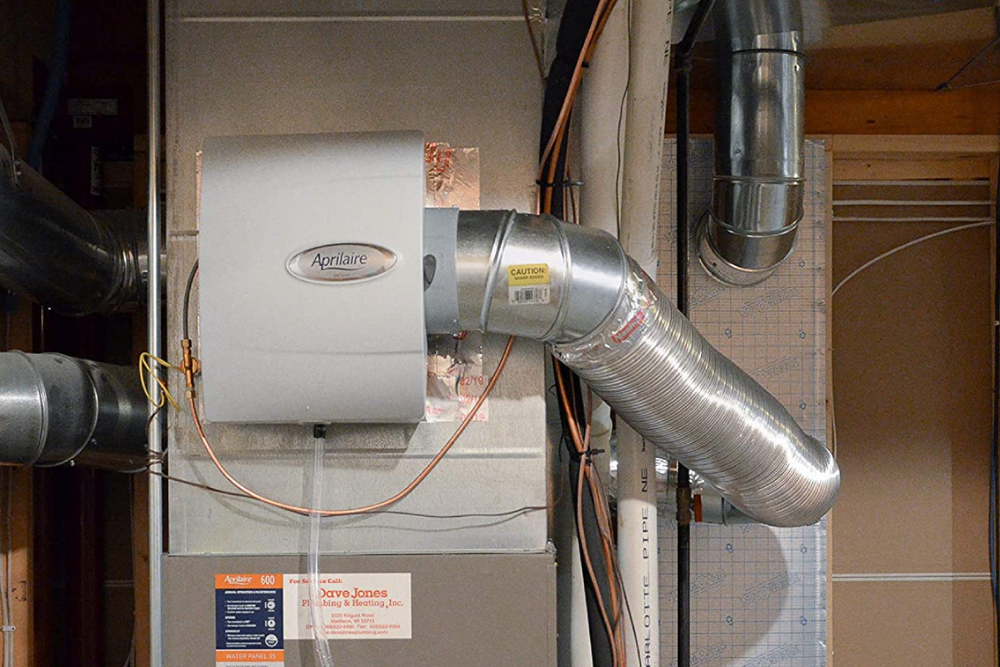
We may earn revenue from the products available on this page and participate in affiliate programs. Learn More ›
When a large portion of your home suffers from dry air, a whole-house humidifier can remedy the problem. Unlike single-room humidifiers, which moisturize the air in small spaces, whole-house systems provide a single, convenient source of balanced humidity.
According to Andrew Hulsebos, service director of Reiner Group Inc., an HVAC company headquartered in New Jersey, the dry air caused by low humidity can do more than just irritate your sinuses or damage walls and ceilings. “If you notice wooden furniture, flooring, or even doors starting to warp or crack, or if paint is peeling from walls, low humidity levels could be the cause,” he said.
To help you win the war against damaging dry air, we reviewed more than 30 top-rated humidifiers and chose eight that fit a variety of common needs. Below are some of the best whole-house humidifiers in their respective categories.
- BEST OVERALL: AprilAire 500 Whole-House Evaporative Humidifier
↓ Jump to Review - BEST BANG FOR THE BUCK: Aircare Space Saver 831000 Whole-House Humidifier
↓ Jump to Review - BEST INDUSTRIAL: Lacidoll Commercial & Industrial-Grade Humidifier
↓ Jump to Review - BEST FOR SMALL HOMES: Vornado Evap40 Evaporative Humidifier
↓ Jump to Review - BEST FOR HARD WATER: AprilAire 700 Whole-House Evaporative Humidifier
↓ Jump to Review - BEST PORTABLE: Aircare Console MA1201 Evaporative Humidifier
↓ Jump to Review - BEST PEDESTAL: Aircare Pedestal Whole-House Evaporative Humidifier
↓ Jump to Review - BEST CONSOLE: Aircare Credenza 696400HB Evaporative Humidifier
↓ Jump to Review
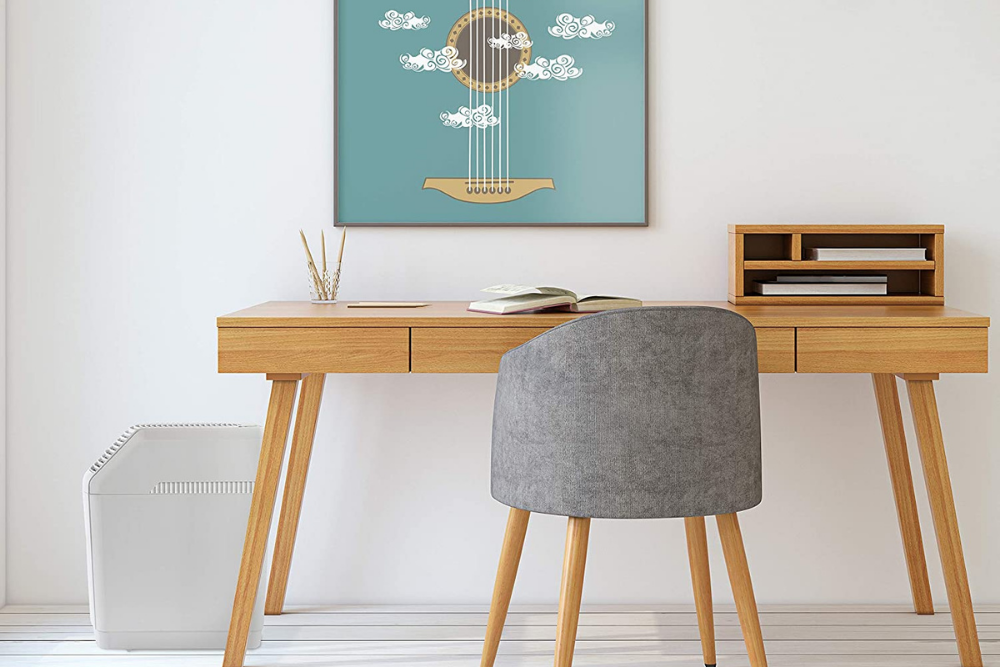
Our Top Picks
The whole-house humidifier market is dominated by several established brands that produce high-quality and reliable systems. Some are standouts in their respective categories, and this list of top picks can help make finding the best whole-house humidifier for specific needs quicker and easier.
Best Overall
AprilAire 500 Whole-House Evaporative Humidifier
Product Specs
- Coverage: 3,500 square feet
- Maximum runtime: Continuous
- Tank capacity: 12 gallons per day
What We Like
- Sensors for outside temperatures and relative humidity levels
- Automatically maintains humidity indoors
- Easy-to-read panel provides convenient monitoring and control
- Compact design with a very competitive price
What We Don’t Like
- Professional installation recommended
The American-made AprilAire 500 has earned the top spot on our best whole-house humidifier list due to its efficiency, comprehensive feature set, and ease of use. Its maximum coverage area is 3,500 square feet, which is more than enough for the average home, which is about 2,300 square feet, according to the latest U.S. Census Bureau figures.
We like that this unit has two sensors: one for outside temperature and one for relative humidity. Once the desired level is set using the clear digital display, the AprilAire humidifier automatically adjusts performance to suit. This reduces power and water consumption, keeping bills lower.
The additional external sensor makes installation more complex than some, but the affordable price compensates for any increased labor costs. It’s also one of the best-rated whole-house humidifiers on the market.
Get the AprilAire 500 whole-house humidifier at Amazon.
Best Bang For The Buck
Aircare Space Saver 831000 Whole-House Humidifier
Product Specs
- Coverage: 2,700 square feet
- Maximum runtime: 70 hours
- Tank capacity: 6 gallons
What We Like
- Compact design fits smaller spaces
- Offers three fan speeds and an adjustable humidistat
- Automatically shuts off at set humidity level
- Low noise levels
- Casters offer easier mobility
What We Don’t Like
- Bright control panel
- Some reports of faulty fan switches
Space is often at a premium in modern homes, making this Aircare’s compact dimensions ideal. Despite its diminutive size, it can provide humidity for up to 2,700 square feet of space. It also has three fan speeds that allow users to manage performance and volume.
The unit can be noisy when working hard but will shut off when it reaches the user-set humidity level. The easy-fill water tank holds 6 gallons, allowing up to 70 hours of continuous output.
This large capacity humidifier alerts when the water level is low and when the filter needs to be changed. The Aircare Space Saver offers outstanding value for the money.
Get the Aircare whole-house humidifier at Amazon, The Home Depot, or Walmart.
Best Industrial
Lacidoll Commercial & Industrial-Grade Humidifier
Product Specs
- Coverage: 2,000 square feet
- Maximum runtime: 12 hours
- Tank capacity: 5.5 gallons
What We Like
- Has a large, 5.5-gallon water tank
- Humidifies over 2,000 square feet
- Runs for up to 12 hours
- Features an intelligent constant humidity control
- Comes with multiple presets, timers, and remote control
What We Don’t Like
- Smaller coverage area compared to other options
- Some users have reported dampness and small leaks
Anyone looking for a unit for their office, workplace, or growing center will want to check out the Lacidoll humidifier. It features a 5.5-gallon water tank capable of covering over 2,000 square feet of space. It also has a maximum 12-hour runtime, timers, a 2,000 mL/h output, and four integrated mist/humidity levels due to the onboard atomizers.
This top-fill 110-watt unit is ideal for industrial or commercial applications. It comes with intelligent constant humidity control to keep your preferences in check, and the large LED display and remote control make the unit easy to set and forget.
If you’re worried about noise, this might be the unit for you. It runs at a low 35-decibel operating noise level, which is about the equivalent of the sound of a whisper. It also comes with 13 accessories for excellent versatility.
Get the Lacidoll whole-house humidifier at Amazon.
Best for Small Homes
Vornado Evap40 Evaporative Humidifier
Product Specs
- Coverage: 1,000 square feet
- Maximum runtime: 24 hours
- Tank capacity: 4 gallons per 24 hours
What We Like
- Vortex action evenly distributes humidity
- Simple controls make it easy to use
- Affordable option for smaller homes and apartments
What We Don’t Like
- Regular filter replacement can be inconvenient and expensive
- No auto-off feature
Most large HVAC humidifiers for home use are overkill for those who live in small spaces. Yet many room humidifiers don’t provide sufficient coverage. One efficient, low-cost solution is the Vornado Evap40 Evaporative Humidifier.
This unit offers three fan speeds and a clever vortex action that spreads humidity evenly over an area of up to 1,000 square feet. Two easy-to-manage 2-gallon tanks give 24 hours of runtime at the highest fan setting. Automatic sensors adjust humidity to the chosen level.
The Vornado would also be a good choice for large single rooms, though its lack of wheels makes it a bit awkward to move around.
Get the Vornado whole-house humidifier at Amazon, The Home Depot, or Wayfair.
Best for Hard Water
AprilAire 700 Whole-House Evaporative Humidifier
Product Specs
- Coverage: 5,300 square feet
- Maximum runtime: Continuous
- Tank capacity: 18 gallons per day
What We Like
- Runs off ordinary household water
- Sensors monitor and deliver optimal humidity
- Easy-to-read digital control panel
What We Don’t Like
- Professional installation required for warranty
- Water panel must be replaced annually
The minerals in hard water can wreak havoc on whole-house HVAC humidifiers. Some eject calcium and magnesium into the air, aggravating breathing conditions. White dust can settle out, too, covering furniture and getting into sensitive electronics. Others trap the chemicals, but the buildup eventually causes blockages or damage.
We like the AprilAire 700 for homes with hard water since it can operate with hard or soft water and a hot or cold supply. Minerals from hard water are collected in the water panel, preventing them from getting into the air.
Other key features of the AprilAire 700 are precise digital control, sensors to automatically monitor humidity levels, and a powerful fan that uses furnace air to increase humidification speed over an area of up to 5,300 square feet.
Get the AprilAire 700 whole-home humidifier at Amazon.
Best Portable
Aircare Console MA1201 Evaporative Humidifier
Product Specs
- Coverage: 3,600 square feet
- Maximum runtime: 36 hours
- Tank capacity: 3.6 gallons
What We Like
- Compact, mobile, and affordable unit
- Easy-to-use digital controls
- Four fan speeds and an auto shutoff feature
- Has indicators for water level and filter check
What We Don’t Like
- Must replace evaporative wick regularly
The modest size of this Aircare whole-house humidifier belies its performance, which covers up to 3,600 square feet. The digital humidistat is controlled by a clear and easy-to-use front-mounted panel. Once set, it can be left to regulate humidity automatically.
If you want to move this humidifier from one place to another, casters and a built-in handle make the task almost effortless. Four speeds allow you to choose between high output and low noise.
The tank size is modest at 3.6 gallons and provides a maximum runtime of 36 hours. However, given the performance, that’s perhaps not a major drawback. This Aircare humidifier is also very competitively priced.
Get the Aircare 3.6-gallon whole-house humidifier at The Home Depot, Amazon, or Walmart.
Best Pedestal
Aircare Pedestal Whole-House Evaporative Humidifier
Product Specs
- Coverage: 2,400 square feet
- Maximum runtime: 60 hours
- Tank capacity: 3.5 gallons
What We Like
- Features 9 fan speeds for fine humidity control
- Easy-fill reservoir comes with low-water indicator and auto-shutoff
- Customizable top can accept any 12-inch-by-12-inch tile
What We Don’t Like
- Higher fan speeds may be noisy
The Aircare pedestal humidifier is designed to fit into a variety of decors and provides an extra table surface. The discreet, easy-to-use control panel is the only thing that gives away its true purpose. For added coordination, the top can be swapped out for any 12-inch-by-12-inch tile.
Coverage of 2,400 square feet makes it ideal for apartments, small homes, or guest accommodations. While not designed to be portable, it weighs only 25 pounds so it’s not difficult to move.
Although the 3.5-gallon tank is modest, its high efficiency and choice of nine fan speeds mean this Aircare can provide humidity for up to 60 hours. There’s a low-water indicator and an auto shutoff to prevent damage or wasted electricity should the tank run dry.
Get the Aircare pedestal whole-house humidifier at The Home Depot or Amazon.
Best Console
Aircare Credenza 696400HB Evaporative Humidifier
Product Specs
- Coverage: 3,600 square feet
- Maximum runtime: 45 hours
- Tank capacity: 5.6 gallons
What We Like
- Digital humidistat automatically maintains chosen humidity level
- Energy-saving shutoff at desired humidity
- Easy-to-fill twin 2.8-gallon water tanks
What We Don’t Like
- Bulky appearance; won’t suit everyone’s taste
With its wood-grain effect and classic credenza styling, this Aircare can be an unobtrusive addition to many homes. It’s one of the most powerful console humidifiers on the market, with a coverage area of up to 3,600 square feet.
The built-in humidistat with digital whole-house control allows precise adjustment of the environment. Once set, it only needs to be refilled with water periodically. The twin tanks must be removed to refill, but it’s not too onerous a task, with each tank being 2.8 gallons. When the tanks are full, they offer a maximum runtime of 45 hours. There are three fan speeds and an automatic shutoff for when the desired humidity is reached.
This Aircare unit is a good whole-house humidifier that can blend in with existing decor. However, it weighs more than 30 pounds and has no wheels, so you’ll need to exercise caution when moving it.
Get the Aircare credenza whole-house humidifier at The Home Depot, Amazon, or Walmart.
Jump to Our Top Picks
How We Chose the Best Whole-House Humidifiers
As an engineer and someone who has installed whole-house humidifiers, I have a hands-on understanding of how they function. To support this, the BobVila.com team researched the latest models from every leading manufacturer to ensure we had up-to-date information. Feedback from customers who live with these devices day-to-day also formed an important part of our selection process.
In making my choices, I wanted to provide a wide range of options encompassing the various technologies and different types of installation. With the breadth of high-quality options, I have provided solutions for the widest possible range of needs, as well as whole-house humidifiers to suit most budgets.
Although the number of manufacturers represented is relatively low, I felt it important to focus on brands that have built a reputation for producing reliable, durable equipment. In the longer term, this ensures buyers get the best value for their money.
What to Consider When Choosing a Whole-House Humidifier
Finding the best humidifier for any given home is easier when shoppers understand the most important technical and practical features. The type, effectiveness, ease of use, coverage area, installation, and whole-house humidifier cost must all be taken into consideration.
Types and Effectiveness
Whole-house humidifiers can be divided into two distinct categories: those that work with an existing HVAC system and those that are freestanding console models.
Whole-home humidifier installation requirements for models that work with an HVAC system vary. Some can be installed by DIYers with moderate skills, while others will require an HVAC engineer. Once installed, though, whole-house humidifiers that work with HVAC systems need little attention. They connect to the existing electrical and water supply systems in the home.
Whole-house humidifiers that work with an HVAC system can further be divided into three types:
- Steam humidifiers are generally the most powerful and are often used for large homes. They heat water in a steam canister until it boils and then release the steam through the ventilation ducting. A whole-house steam humidifier can be expensive, and its energy consumption is higher than other types.
- Bypass humidifiers do not need to heat the water because they use the warmth from the furnace. Water is held in a panel, which is usually replaced annually. Water particles pass through the ducting in the same ways as a steam humidifier.
- Fan humidifiers don’t use heat at all. They blow air across a humidifier pad that is soaked in water. Again, this releases fine water particles through the ducting. They are more energy efficient and, because there’s no warm air, they don’t affect air cooling. Fan models are one of the best humidifiers for large rooms.
Bypass and fan humidifiers are also known as evaporative humidifiers because they don’t rely on steam.
Whole-house console-style evaporative humidifiers are much simpler. They just need to be placed where preferred, filled regularly with water, and plugged into a convenient power outlet.
There’s also the question of noise. Permanent installations near the furnace seldom have a noise impact on the living space, whereas console whole-house humidifiers can make a noticeable noise, particularly on high fan settings.
Cool-mist models are the loudest, as they need a fan to project moisture. Usually only found on room-size humidifiers, warm mist, and ultrasonic models have no fan and are quieter.
Coverage Area
While several clever DIY hacks can improve the moisture level in a home environment without the added expense of a new unit, these are not practical, nor are they consistent and reliable solutions to provide coverage throughout the entire home.
The coverage area required depends on the size of the home. In general, a console-style evaporative humidifier is less powerful and has less coverage than its HVAC counterpart. They range in coverage from around 2,500 to 3,600 square feet, which will be sufficient for many homes. However, HVAC systems can humidify more than 6,000 square feet.
When shoppers are checking the coverage area offered, it’s common to see the expression “tightly built home.” This describes a fully insulated living space where doors and windows also fit properly and thus the internal environment is well sealed. Older homes may not be so tightly built.
Those homes that aren’t fully insulated or have occasional drafts could require a model 40 to 50 percent more powerful for effective humidification. Alternatively, a home’s owner can remedy those deficiencies. This would lead to the need for a less expensive humidifier and a more energy-efficient home, reducing heating system bills.
There’s another element to coverage that needs to be considered, and it relates to the type of whole-house humidifier chosen. If one that works with an HVAC system is selected, then even closed rooms still receive humidity. With a console model, a closed door cuts a room off from the humidified air supply.
Water Tank and Runtime
Since whole-house humidifiers that link to the HVAC system are plumbed in, the supply is continuous. However, a water consumption rating is still generally given.
Console models are not connected to the household plumbing. They have onboard water tanks that need to be refilled periodically. How often that is required will affect overall convenience. As they can’t provide humidification when the tank is empty, this also affects runtime.
How efficiently the humidifier runs, the coverage area, and the desired humidity level demanded by the occupants all have an impact. It’s impossible to say, for example, that a particular tank size offers a specific runtime. A small device for a 1,500-square-foot home might run longer than a large one for a 3,000-square-foot home when providing humidity over a smaller area, but it will empty much more quickly if the space is beyond its intended capacity.
Since there is no general runtime guideline, each model needs to be checked and compared to those with similar output and features. However, most units run anywhere from 24 to more than 40 hours between refills. Manufacturers give reasonable guidance within product specifications, though the amount of moisture loss through gaps around doors and windows or due to lack of insulation will likely reduce runtime.
Ease of Use
In most whole-house humidifiers, a built-in sensor called a humidistat (also known as a hygrometer or hygrostat) monitors humidity levels and turns the device on and off to maintain a consistent level. In addition to providing the level of comfort desired, it minimizes water and power consumption.
Console large room humidifiers usually have water-level monitoring and will turn the machine off to prevent damage if it runs dry. Refilling may be possible on the unit, but some require that the tank be filled from a faucet. Bear in mind that a gallon of water weighs more than 8 pounds, so two small tanks might be more convenient than one large tank.
Unless you opt for one of the best filterless humidifiers, which are usually better equipped for smaller spaces, you’ll need to change the filter in your humidifier regularly. In general, filters should be changed every 3 to 12 months, depending on the type of humidifier.
Also, consider the ease of cleaning the humidifier. Humidifiers can develop bacteria, mineral deposits, and mold over time, especially if they are used with hard water.
Additional Features
The following extras may affect efficiency and ease of use.
- Different fan speeds are a huge benefit, allowing the user to boost humidity quickly to combat dry air or run the device more quietly.
- Handles and wheels aren’t only fitted to small portable humidifiers; they can also be found on larger models that might be used in open rooms, guest accommodations, or office spaces.
- Digital controls support the setting of humidity levels with absolute precision. This allows consumers to monitor and adjust performance with much greater accuracy than is possible with a manual dial.
- Smart controls via phone apps and integration with smart-home management systems are becoming increasingly popular. Currently, however, the choices are limited.
FAQs
Now that you are more informed about how to choose the best whole-house humidifier for your particular situation, you may have additional questions. Below are answers to some of the most common concerns about these types of humidifiers.
It certainly can. An increase in humidity can have a positive impact on skin issues and respiratory problems, and it can help suppress some types of viral and infectious diseases. Dry air can also impact pets, so they feel more comfortable with ideal humidity, too. However, people who have specific health issues should always consult a medical professional before installing a humidifier, as these devices may not be appropriate in all cases.
Yes, whole-house humidifiers are safe when properly installed and maintained. Mold has the potential to cause problems, but it shouldn’t occur if the humidifier is properly looked after, allowing the correct indoor relative humidity to be maintained. Parts of an HVAC humidifier may get hot to the touch. Evaporative humidifiers use cool air, so these models are usually considered safe for pets and animals.
Humidifiers can cause mold, but the problem is generally easy to prevent. Mold usually grows when humidity is higher than normal. The United States Environmental Protection Agency (EPA) recommends that homes should ideally have between 30 and 50 percent humidity, which is the range most of these devices cover.
Mold shouldn’t normally grow within these parameters. Stagnant water, however, can also cause problems, so users should clean tanks regularly and empty them when not in use.
The ideal indoor humidity level at home for health and comfort is generally considered between 40 and 50 percent. In the winter, indoor air becomes dry, often requiring the use of a humidifier. The opposite is true in the summer, when indoor air can become overly moist, calling for a whole-house dehumidifier.
Maintenance very much depends on the type of humidifier, and each manufacturer will offer a schedule to help achieve maximum benefit. Some filters need to be changed every 3 months. Steam chambers usually last 6 to 12 months. Humidifier pads are usually replaced annually.
Though several variables make it impossible to give a precise answer, console units would be expected to last 5 years or more. Evaporative humidifiers have filters or wicks that usually last no more than 3 months.
The majority of HVAC-mounted models have a life expectancy of around ten years. Bear in mind periodic maintenance is usually required, and an annual service is usually recommended for HVAC models, and some components may need to be replaced at that time.
Why Trust Bob Vila
Bob Vila has been America’s Handyman since 1979. As the host of beloved and groundbreaking TV series including “This Old House” and “Bob Vila’s Home Again,” he popularized and became synonymous with “do-it-yourself” home improvement.
Over the course of his decades-long career, Bob Vila has helped millions of people build, renovate, repair, and live better each day—a tradition that continues today with expert yet accessible home advice. The Bob Vila team distills need-to-know information into project tutorials, maintenance guides, tool 101s, and more. These home and garden experts then thoroughly research, vet, and recommend products that support homeowners, renters, DIYers, and professionals in their to-do lists.
